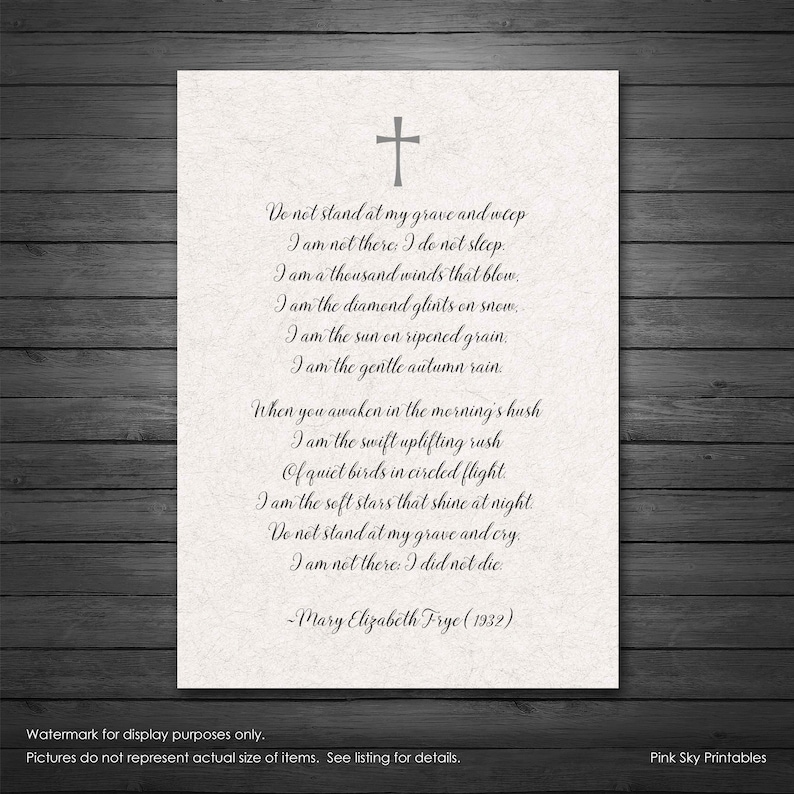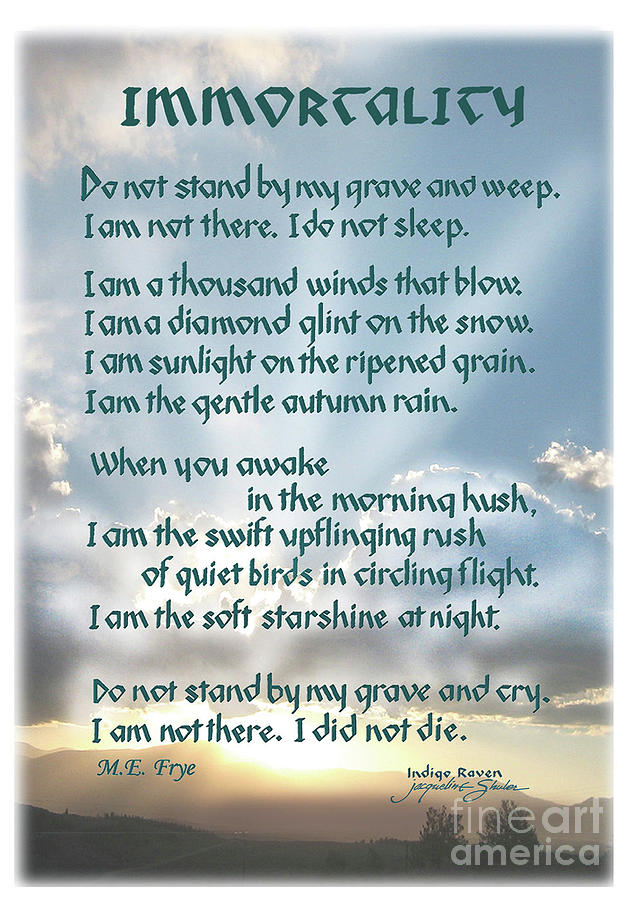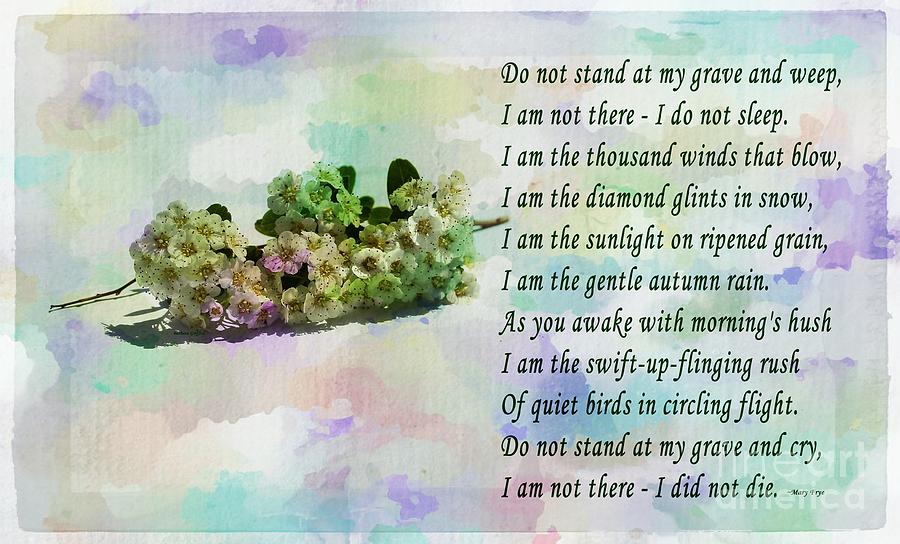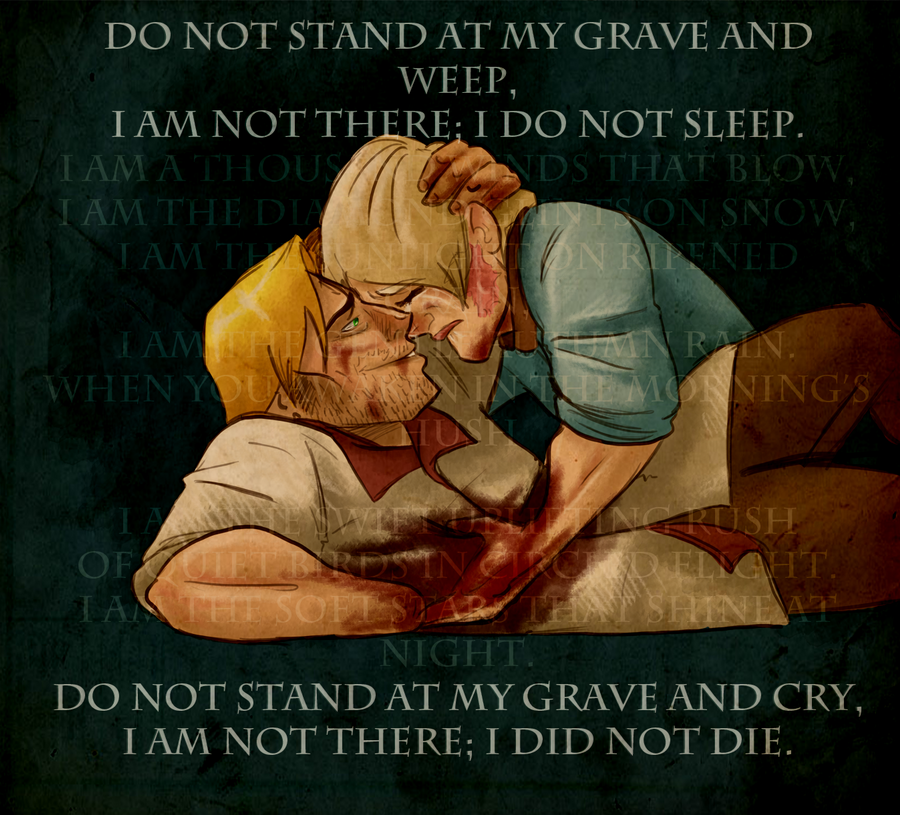
Do not stand at my grave and weep choir kasapvp
'Do Not Stand at My Grave and Weep' I recited this poem at the funeral of my father, who died suddenly at the age of 91 after a good and full life. We wanted the funeral service to be a celebration of his life and I felt that this beautiful poem set the tone for the service.

"Do not stand at my grave and weep" Mary Elizabeth Frye [1600 x 1200
by Mary Elizabeth Frye. Do not stand at my grave and weep, I am not there; I do not sleep. I am a thousand winds that blow, I am the diamond glints on snow, I am the sun on ripened grain, I am the gentle autumn rain. When you awaken in the morning's hush. I am the swift uplifting rush.

Do not stand at my grave and weep Mary Elizabeth Frye Poem Etsy
1 Do not stand 2 By my grave, and weep. 3 I am not there, 4 I do not sleep— 5 I am the thousand winds that blow

Do Not Stand At My Grave And Weep...
The world-famous poem "Do not stand at my grave and weep" was wildly attributed to Mary Elizabeth Frye but it's originally penned by Clare Harner Lyon. The o.

Logical Biz Do Not Stand At My Grave
Do Not Stand at My Grave and Weep: Summary and Analysis. "Do Not Stand at My Grave and Weep" is a well-known poem, usually recited at funerals. It was written by Mary Elizabeth Frye. Little was known about the author, and it remained a mystery until late in the twentieth century; it was believed that its poet was Mary Elizabeth Frye.

Do Not Stand At My Grave And Weep Flowers by Wendy
Do Not Stand At My Grave And Weep by Clare Harner - Famous poems, famous poets. - All Poetry Often attributed to Mary Elizabeth Frye, recent research suggests she plagiarized it from Clare Harner. Do Not Stand At My Grave And Weep Do not stand at my grave and weep; I am not there. I do not sleep. I am a thousand winds that blow.

Lyric Video Do Not Stand At My Grave And Weep YouTube
Do Not Stand at My Grave and Weep. am not there, I do not sleep. am a thousand winds that blow. am the diamond glint on snow. am the sunlight on ripened grain. am the gentle autumn rain. am the swift, uplifting rush Of quiet birds in circling flight. am the soft starlight at night. Do not stand at my grave and weep.

Do Not Stand at My Grave and Weep Photograph by Barbara A Griffin
Lyrics: The poem was written in 1932 by Mary Elizabeth Frye (1905-2004). For some time, the origin of the poem was disputed, but after research by the "Dear Abbey" columnist Abigail van Buren, it was confirmed in 1998 that Mary Frye was indeed the author. (Better late than never!)

Do Not Stand at My Grave and Weep Poem Acrylic Print
One of the most popular bereavement poems in English, "Do Not Stand at My Grave and Weep" holds even more allure for its mysterious origins and many reinventions. A traditional, rhyming anti-elegy, the poem uses imagery and metaphor commonly associated with death and rebirth. The poem's voice, a direct address, reaches out to readers in.

Fine dikt å lese opp i en begravelse Kultur, litteratur og musikk
Do not stand at my grave and weep, I am not there, I do not sleep. I am in a thousand winds that blow, I am the softly falling snow. I am the gentle showers of rain, I am the fields of ripening grain. I am in the morning hush, I am in the graceful rush Of beautiful birds in circling flight, I am the starshine of the night. I am in the flowers.

Do Not Stand At My Grave And Weep YouTube
This beautiful poem is probably one of the world's best known and best loved but, over the years, numerous variations of it have been attributed to Mary Elizabeth Clark Frye, a Baltimore housewife; Stephen Cummins, a British soldier; J.T. Wiggins, an Englishman who migrated to America; and Marianne Reinhardt (no details found).

Do not stand at my grave and weep... by TopHatTurtle on DeviantArt
The poem "Do Not Stand at My Grave and Weep" is a call to action in 12 lines. It's composed of rhyming couplets in iambic tetrameter, though a few lines have extra syllables breaking up the structure to give extra emphasis. To understand what the poem by Mary Elizabeth Frye means, it's best to go line by line. It begins:

Do Not Stand At My Grave And Weep Printable Version Printable Templates
Do not stand at my grave and weep, I am not there; I do not sleep. I am a thousand winds that blow, I am the diamond glints on snow, I am the sun on ripened grain, I am the gentle autumn rain. When you awaken in the morning's hush. I am the swift uplifting rush. Of quiet birds in circling flight. I am the soft starlight at night. Do not stand.

Do Not Stand At My Grave And Weep By Mary Elizabeth Frye Words of
Do not stand at my grave and weep. am not there; I do not sleep. am a thousand winds that blow, am the diamond glints on snow. am the sun on ripened grain, am the gentle autumn rain. When you awaken in the morning's hush, am the swift uplifting rush Of quiet birds in circled flight. am the soft star that shines at night.

Do not stand at my grave and weep robert prizeman lasemalter
A short funeral poem by Helen Lowrie Marshall about happy memories living on after a loved one has gone. Video PDF To Those Whom I Love & Those Who Love Me Beautiful remembrance poem, ideal for a funeral reading or eulogy. Written from the point of view of the person being laid to rest. Video PDF

Do Not Stand at My Grave and Weep Poem Mary Elizabeth Frye
" Do not stand by my grave and weep " is the first line and popular title of the bereavement poem " Immortality ", written by Clare Harner in 1934. Often now used is a slight variant: "Do not stand at my grave and weep". Origins